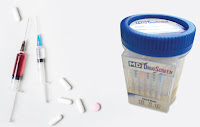Drug testing is a critical process that helps identify the presence of illegal substances or prescription drugs in a person's system. Employers, healthcare providers, law enforcement agencies, and other organizations conduct drug tests for various reasons, such as ensuring workplace safety, assessing patient compliance, or investigating criminal activities. Urine and oral fluid testing are two common methods used for drug screening, each with its benefits and limitations. In this newsletter, we will explore the benefits of drug testing, the differences between urine and oral fluid testing, and the accuracy of each method.
Benefits of Drug Testing
Drug testing provides several benefits, including:
Promotes Safety: Drug use can impair judgment and coordination, leading to accidents, injuries, and fatalities. By conducting drug tests, employers and other organizations can promote a safe and drug-free environment.
Improves Health Outcomes: Healthcare providers may use drug testing to monitor patient compliance with medication regimens or identify drug abuse, leading to better health outcomes and improved treatment plans.
Deters Drug Use: Knowing that drug testing is a requirement can discourage individuals from using drugs, leading to reduced drug abuse rates.
Legal Compliance: Employers in certain industries, such as transportation or healthcare, may be required by law to conduct drug tests as part of regulatory compliance.
Urine Testing vs. Oral Fluid Testing
Urine and oral fluid testing are two common methods of drug screening, and each has its advantages and disadvantages.
Here are some of the key differences between the two:
Collection Method: Urine testing requires the collection of a urine sample, while oral fluid testing involves collecting a sample of saliva or swabbing the inside of the mouth.
Detection Window: Urine testing can detect drug use over a longer period (up to several weeks), while oral fluid testing has a shorter detection window (up to a few days).
Accuracy: Both methods are highly accurate, but urine testing may be more susceptible to adulteration or substitution, while oral fluid testing can be affected by recent drug use, food, or drink.
Convenience: Oral fluid testing is generally considered more convenient and less invasive than urine testing, as it does not require a private restroom or the same level of privacy.
Accuracy of Drug Testing Methods
Drug testing methods vary in accuracy depending on various factors, such as the type of drug being tested, the testing method used, and the timing of the test. However, both urine and oral fluid testing are generally considered reliable methods of drug screening.
Urine testing is more established and has been used for decades, making it a trusted method of drug screening. Urine tests can detect a wide range of drugs and drug metabolites, making them suitable for detecting long-term drug use. However, urine tests can be subject to adulteration or substitution, which can affect their accuracy.
Oral fluid testing is a newer method of drug screening and has gained popularity due to its convenience and shorter detection window. However, oral fluid tests are more susceptible to recent drug use, food, or drink, which can affect the results. Additionally, oral fluid testing may not be as accurate in detecting long-term drug use.
In conclusion, drug testing is a critical process that helps identify drug use, promote safety, improve health outcomes, and deter drug abuse. Urine and oral fluid testing are two common methods of drug screening, each with its benefits and limitations. While both methods are generally considered reliable, they differ in their collection method, detection window, and accuracy. Organizations should consider their specific needs when choosing a drug testing method and work with a trusted laboratory to ensure accurate and reliable results.







Comments
Post a Comment